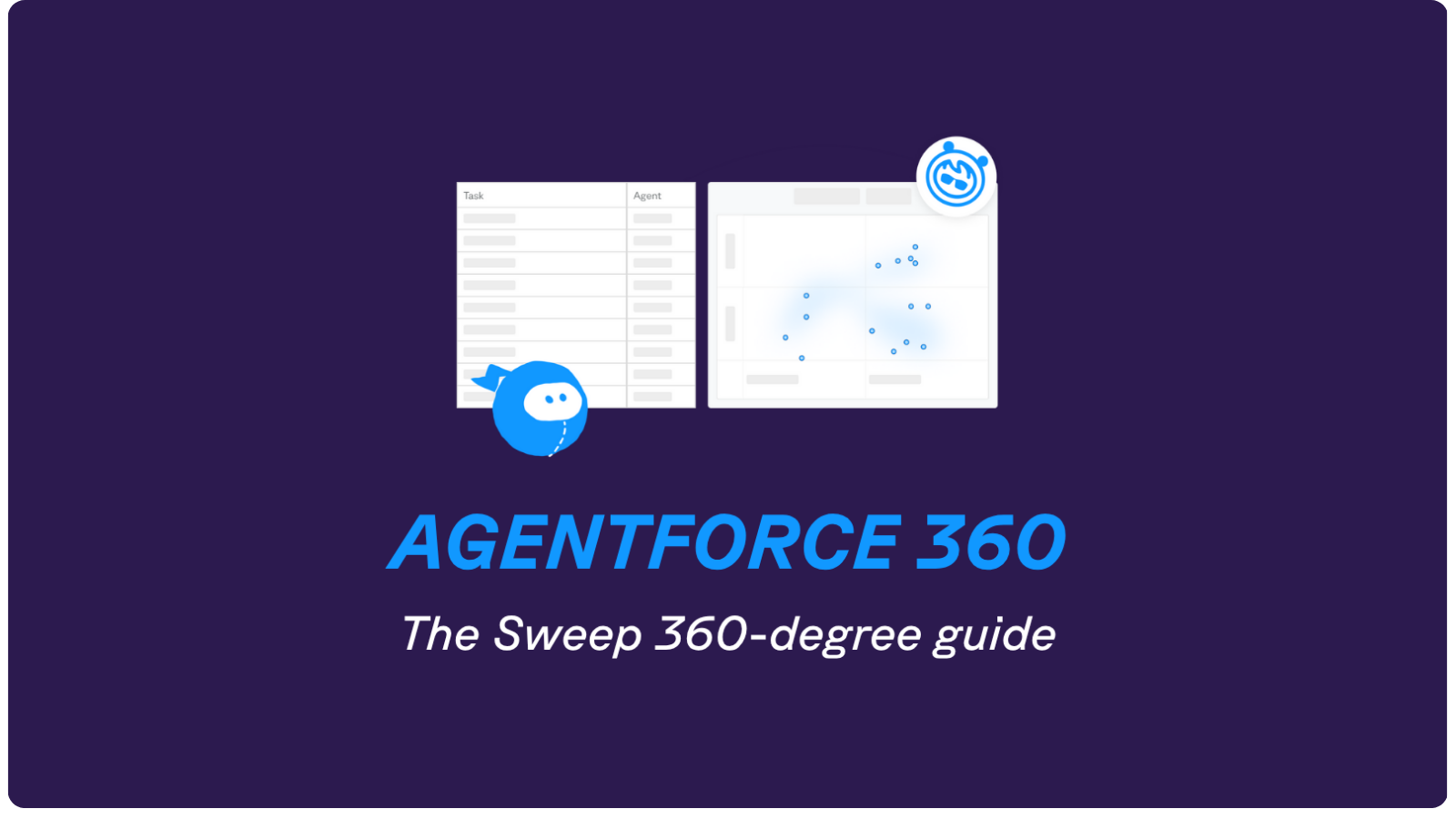According to TechCrunch, Salesforce just dropped Agentforce 360—and while Dreamforce doesn’t officially kick off until tomorrow, the fireworks have started early.
If 2024 was the proof-of-concept year for agentic AI inside Salesforce, 2025 is what you might call The Big Scale-Up.
This year’s story is bigger, louder, and—thankfully—more unified. It’s also a clear signal that the “AI agent” has evolved from a generic buzzword into the new atomic unit of enterprise software.
So, given that I’m not at Dreamforce and have nothing but time on my hands, let’s unpack what’s actually new, what’s recycled, and what it all means for teams trying to build something real.
What Agentforce 360 actually is
At its core, Agentforce 360 is Salesforce’s ambitious attempt to connect humans, AI agents, apps, and data into one continuous loop of context and action.
It’s less a rebrand than a re-architecture — an effort to bring the company’s sprawling suite (Customer 360, Data Cloud, Slack, MuleSoft, Tableau, etc.) into a single, cohesive, agent-oriented framework.
The idea: no more disconnected AI pilots or siloed chatbots. Everything now lives inside one agentic stack:
- Agentforce Platform – the logic, reasoning, and runtime layer powered by the configurable Atlas Reasoning Engine.
- Data 360 (formerly Data Cloud) – the context engine that feeds agents structured and unstructured data.
- Customer 360 Apps – where all that sales, service, marketing, and commerce data actually lives.
- Slack – re-positioned as the Agentic Operating System, the conversational front end for everything.
The version lineage
Agentforce 360 arrives after a year of rapid iteration. Let's take a look at the timeline:
- Agentforce (Oct 2024) – the debut of Salesforce’s enterprise AI agent platform.
- Agentforce 2 (Dec 2024) – Atlas Reasoning Engine upgrades for predictability.
- Agentforce 2dx (Mar 2025) – cross-functional, embedded agents.
- Agentforce 3 (Jun 2025) – enhanced governance and interoperability.
- Agentforce 360 (Oct 2025) – unifying all of it into a single, end-to-end platform.
What’s new
While much of Agentforce 360 builds on last year’s announcements, there are several genuinely new layers worth noting:
Hybrid reasoning with Agent Script
Salesforce’s answer to the hallucination problem. Agent Script is a human-readable JSON-style expression language that lets developers define deterministic “if/then” logic, tool use, and guardrails — keeping agents predictable while allowing LLMs to stay creative. It’s in beta this November, and if it performs as advertised, it’s a big deal.
Revamped Agentforce Builder
A conversational development studio where builders can create, test, and deploy agents using either natural language or code. Think Flow Builder meets Copilot, with multi-view editing (doc, canvas, script) and live debugging.
Agent Studio + Agent observability
Salesforce doesn’t want your agents running wild. Observability dashboards let teams monitor reasoning, accuracy, and compliance — the “continuous improvement flywheel.”
Agentforce voice
Native voice integration brings live, interruptible conversations between AI agents and humans, with full context hand-off and low-latency transcription. Ambitious, risky, but potentially transformative — especially for Service Cloud and Slack fusion.
Multi-Agent orchestration via MuleSoft
MuleSoft is now the “Agent Fabric,” coordinating multiple agents (including third-party ones) so they authenticate, act, and collaborate in sync — the conductor for Salesforce’s AI orchestra.
Agentforce Vibes
A new low-code AI partner that lets developers “vibe-code” apps through natural language and contextual understanding. Think pair-programmer meets Copilot, designed for faster iteration and more creative agent behavior.
The data backplane: Informatica + Apromore (Still in Motion)
Salesforce’s recent acquisitions — Informatica (pending close) and Apromore (announced alongside Agentforce 360) — appear to underpin this next data layer.
- Informatica acts as the data unifier, turning enterprise metadata into a governed, searchable catalog and giving Data 360 the governance muscle it’s long needed.
- Apromore adds process intelligence — so agents can actually understand how work happens before trying to automate it.
Officially, Salesforce hasn’t framed them as the “backplane,” but the architecture points that way. Consider it an educated guess — and a smart one.
If 2024’s Agentforce was about making AI do tasks, 2025’s Agentforce 360 is about making AI understand your business before it touches anything.
Slack: The Agentic OS
Perhaps the most consequential piece of this release is Slack itself.
Parker Harris put it bluntly: “Slack is becoming the front end of Salesforce.”
Translation: you may never log into Salesforce again. You’ll talk to your agents inside Slack.
Slack will soon host:
- A personal agent (pilot early 2026)
- Slack-first apps for sales, service, ITSM, and HR
- Enterprise search across Salesforce and external tools (Google Drive, GitHub, Jira, etc.)
- A reimagined Slackbot, now context-aware and multi-agent
- Channel Expert Agents that sit in Slack threads and answer domain-specific questions
It’s a clear bid to make Slack the operating system for work — the friendly face on what has often been an intimidating UI.
Pricing: Flex Credits and CBE (Consumption-Based Everything)
Salesforce is quietly moving toward consumption-based pricing for agents. “Flex Credits” are the new currency — you pay per action rather than per seat.
The exact rates aren’t public, but pilot customers suggest a model somewhere around $500 per 100 K credits (estimated $0.10 per action), depending on configuration. That might change, but the takeaway is clear: Salesforce wants to align agent cost with usage.
Expect CFOs to start asking, “What’s an action worth?” sometime around Q4. 🙃
Model flexibility
For aficionados of other models, Agentforce 360 now supports Google Gemini, joining OpenAI and Anthropic as models for the Atlas Reasoning Engine.
That makes the platform more open and adaptable to different enterprise requirements, a smart move for governed AI deployments.
Early Proof Points (and Chunky Grain of Salt)
Salesforce claims Agentforce is already live with 12,000 customers across 200 industry workflows. Names like Under Armour, Williams Sonoma, DirecTV, Heathrow Airport, and Reddit were highlighted as early adopters.
Impressive, yes — but many use cases are still narrow or internal. Agentforce 360 is real, but not yet evenly deployed.
The Agentic Enterprise in Practice
The big idea is to turn every system into an active participant, not a static database. Salesforce wants enterprises to move from “systems of record” to systems of action.
The challenge: most companies don’t have their data, processes, or governance anywhere near ready for that.
And that’s where metadata comes in.
Our Take: Metadata Is Still the Missing Link
At Sweep, we absolutely love what Salesforce is doing here — but we also know what’s missing.
Agentforce 360 can only be as smart as the metadata that fuels it. If your Salesforce instance is messy — if flows, automations, and dependencies are undocumented — then your shiny new agents will be guessing, not governing.
That’s why we built the Agentic Assessment for Agentforce implementation: a 3-to-5-day automated discovery that maps your Salesforce metadata, identifies agent-ready tasks, and ranks them by ROI.
No decks, no consultants, no endless discovery loops — just beautiful clarity.
It’s the bridge between promise and production.
What to Watch at Dreamforce
- Agent Script demos — will we see the deterministic layer in action?
- Slack personal agent previews — how seamless will it feel?
- Apromore integration details.
- Informatica close date and roadmap.
- Real ROI stories from Agentforce users — not just logos.
The Bottom Line
Agentforce 360 is the clearest signal yet that agentic AI is moving from concept to necessary architecture. Salesforce has done what it does best: packaged a movement, branded it, and brought it to the enterprise.
But the work underneath — clean data, usable metadata, and context that doesn’t drift — will determine who actually wins.
If Agentforce 360 is the engine, metadata is the fuel.
And we’re here to keep it clean, connected, and ready for lift-off.
Fill ’er up?

